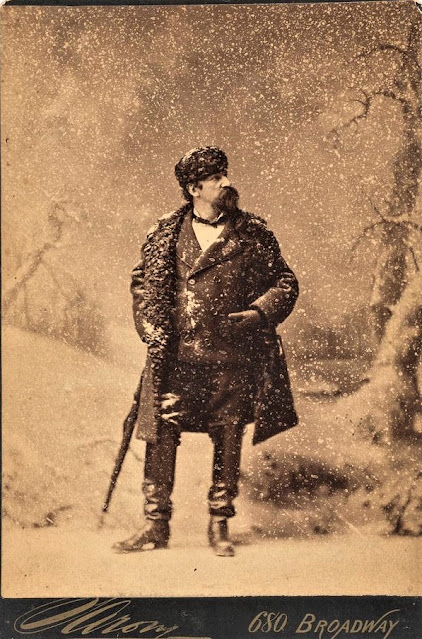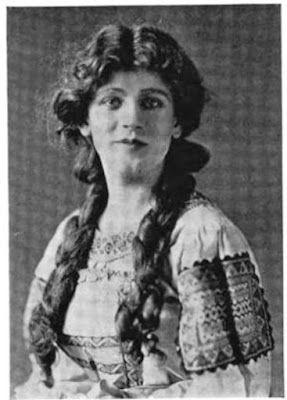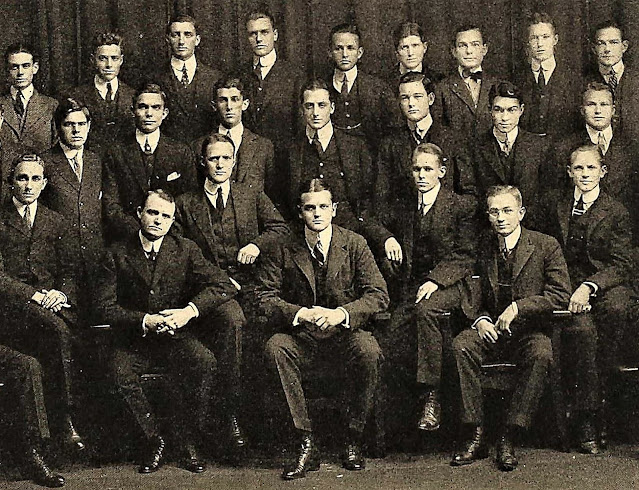If Ellery Queen was the King of Golden Age American detective fiction, was Rufus King its Queen? I will be looking at this question over several blog posts.
Rufus King was born in New York City on January 3, 1893 to Thomas Armstrong King, a doctor, and his wife Amelia Sarony Lambert, a daughter of photographer Theodore Sarony Lambert and great niece of Napoleon Sarony, the most renowned photographer in late nineteenth century America.
Thomas King was one of two sons of dry goods merchant Washington King and his wife Maria Louisa Hill, of the small town off Mooers in northeastern New York, near the Canadian border. They were a couple whose roots ran deep in the rocky soil of New England. Both of their their sons, however, were exceptional young men who would end up denizens of the cosmopolitan big city.
Their elder son, Charles Francis King, was a full decade older than Thomas (who was born in 1866) and he turned out to have rather a strange and interesting history, but more on that later.
In the immediate term Charles graduated in 1880 from Lehigh University of Bethlehem, Pennsylvania and became a prominent mining engineer, said to have been associated in several ventures with iron and steel tycoon and philanthropist Andrew Carnegie. He likely was the same Charles Francis King who was once employed as a chemist with the Pennsylvania Steel company.
Thomas King graduated from Lehigh University and later, in 1888, the University of Vermont College of Medicine at Burlington. He practiced medicine in New York City and on November 24, 1890 married Amelia Sarony Lambert at St. Stephen's Roman Catholic Church. After the marriage the young couple resided with Amelia's widowed mother Margaret at her home at 141 Lexington Avenue, along with Amelia's brother and sister Thomas and Nora, both artists and actors. (There were a couple of other Lambert daughters as well, but apparently they married.)
Thomas King's own mother and father had passed away in 1883 and 1885 respectively and he was, well, estranged from his brother. It appears that he basically was adopted by the Lamberts, or Sarony-Lamberts as they were sometimes called. Or perhaps one should say they adopted him.
.jpeg) |
| the King house at Rouses Point, overlooking Lake Champlain |
In Rouses Point, a small New York town located on Lake Champlain, a couple of miles south of the Canadian border and but a short distance from his home town of Mooers, Thomas King bought the old Ezra Thurber house, a lovely porticoed brick Georgian home built in 1818 that was said once to have been a stop on the Underground Railroad that American slaves traveled to freedom in Canada before the Civil War. It is also claimed President James Monroe stayed there, though I don't believe he was running away form anything.
Amelia and her and Thomas' only child Rufus, born about two years after their marriage, spent quite a bit of the year at the house at Rouses Point, along with Amelia's mother Maggie and her siblings Thomas and Nora. Thomas King, a successful New York doctor, presumably spent much of his time making money in the City by ministering to the medical needs of well-off patients. All of them, barring Rufus himself, are interred in the family vault at Rouses Point. King must have been a successful physician to support all this; interestingly the great American playwright Eugene O'Neill mentions consulting Dr. King about his nerve pain in 1920, the year that saw the premiere of his hit play The Emperor Jones.
 |
| Rufus King's aunt Nora Sarony Lambert (1885-1934), seventeen years younger than his mother Amelia Sarony Lambert |
Evidently King converted to Catholicism when he married into the Sarony-Lambert clan, Amelia's parents both being of the Catholic faith, her father Theodore being a French Canadian and her mother Margaret, or Maggie, Irish. Theodore followed in the footsteps of his famous uncle, Napoleon Sarony, taking up photography; but at one point earlier in his life he owned a wax museum in Montreal, filled with "life-size models of celebrities." (This might well have given Rufus King the notion of the "murder rooms" in his suspense thriller Museum Piece No. 13; see my review here.)
However, Theodore Lambert died in 1888 at the age of 45 and his widow Maggie does not appear to have come from a well-off background. (She may have been employed as a housekeeper in 1860.) Marriage for her eldest daughter to promising young Dr. King may have been a godsend.
Neither Thomas nor Nora appear ever to have married and to have lived rather dilettante existences, falling back on their wealthy brother-in-law when "resting." Thomas died in 1920 and Nora 14 years later in 1935; both, oddly, were the same age, only 49, at their deaths.
It's not surprising that the Sarony-Lamberts emphasized for all it was worth their connection to Napoleon Sarony, who died at the age of 75 in 1896 when Amelia was 28 years old and Rufus but 3, for Sarony was, according to the New York Metropolitan Museum, "an acknowledged master of celebrity photographs" who "succeeded Matthew Brady as the best-known portrait photographer in New York." Indeed, says the Broadway Photographs website, doing the Met one (or more) better: "From 1870 until his death in 1896, Napoleon Sarony was deemed the premier portrait photographer of the United States, and one of the greatest in the world."
He photographed oodles and oodles of celebrities, including, in some of their most iconic photos, Oscar Wilde and Nikola Tesla, and others like Mark Twain, William Tecumseh Sherman, actress Sarah Bernhardt and actor Joseph Jefferson (grandfather of mystery writer Jefferson Farjeon) and bodybuilder Eugen Sandow. I'll pause to show some of these immediately below.
 |
| Oscar Wilde |
 |
| Eugen Sandow |
.jpg) |
| Joseph Jefferson |
 |
| Napoleon Sarony selfie |
.JPG) |
| Nikola Tesla |
 |
| Rufus King's Yale senior photo, 1914 |
 |
| Rufus as scheming maidservant Tanya in Leo Tolstoy's play The Fruits of Culture (1889). Tolstoy died the previous year to the Yale Dramat's performance of the play in 1911. |
 |
| Rufus (left) and a classmate on the Yale Dramat |
 |
| Rufus King at the Yale Dramat, lower right corner (second row). To his left is the student he sat next to in the above photo. In the upper left corner is Cole Porter. |


""Rufe" stood only five feet six and a half inches. "
ReplyDeleteThat was probably short, but not exceptionally short for King's time. Average heights for men were about three or four inches less than nowadays. What is surprising is that King "excelled on the rowing team", where height, weight and leverage are vital, or was he a member of a lightweight crew?
He was the coxswain. He grew up by Lake Champlain and knew boating and "water sports" very well. No GPS in those days though!
Deletehttps://centerfieldmarist.com/2019/09/27/the-brain-of-the-boat-coxswains-are-the-smallest-rower-with-the-most-power/
The Brain of the Boat: Coxswains are the Smallest Rower with the Most Power
BY SAM DIGIOVANNI POSTED ON SEPTEMBER 27, 2019
"Upon first glance, the coxswain on a rowing team seems similar to the kicker on a football team. They’re the smallest athlete of the crew and their job is noticeably different from everyone else’s. However, the coxswain is actually more similar to a quarterback.
“They’re pretty much in charge of the whole race,” says Tom Sanford, the Director of Rowing at Marist. “They are a coach while they’re on the water”. Sanford also likened coxswains to jockeys in a horse race.
The most important position on a rowing team, the coxswains are the ones responsible for steering the boat. They do this mostly by yelling loudly, but they also use a rudder and a GPS system that displays the boat’s performance metrics, such as speed and strokes per minute, on a screen. They have to be small in stature so that they don’t weigh down the boat and also possess great leadership skills."
I think 5'7" is dead-on for a male coxswain. In 1942 he weighed 155 pounds but I'm guessing he weighed less thirty years earlier, when he was at Yale.
His height was also better for playing female parts in the Yale Dramat. He would still have been a tall woman, but possible. When he played the female lead in Shaw's The Devil Disciple, the male lead was 6'1".